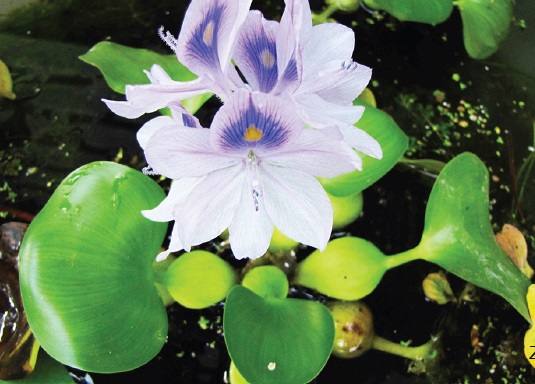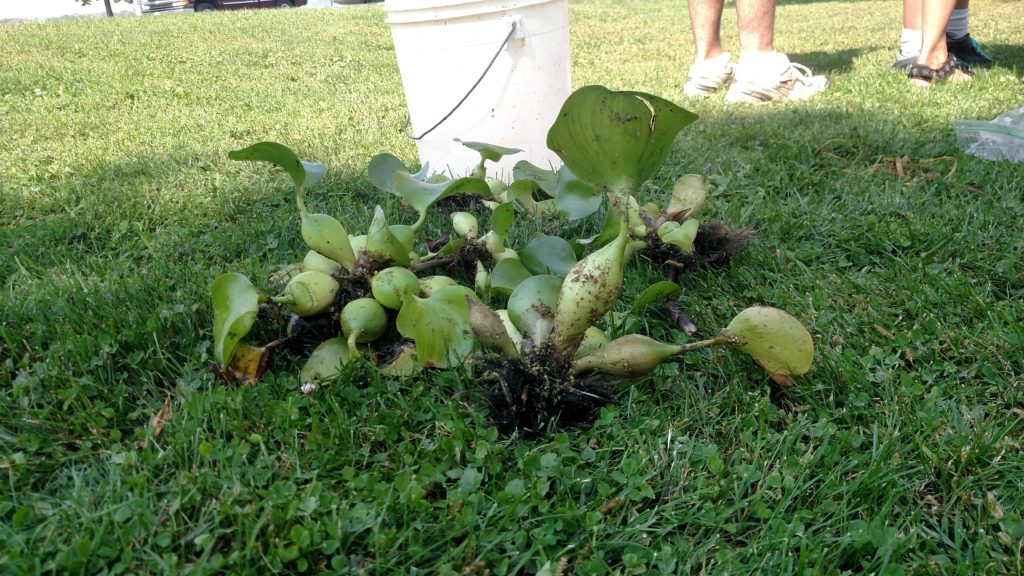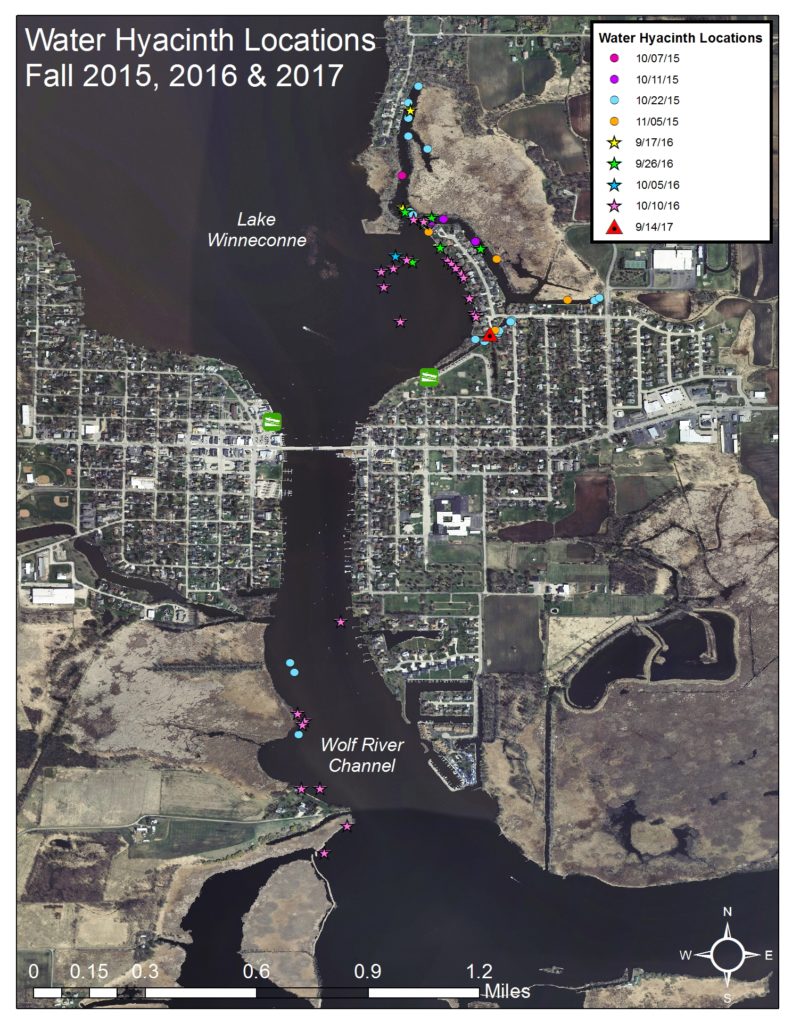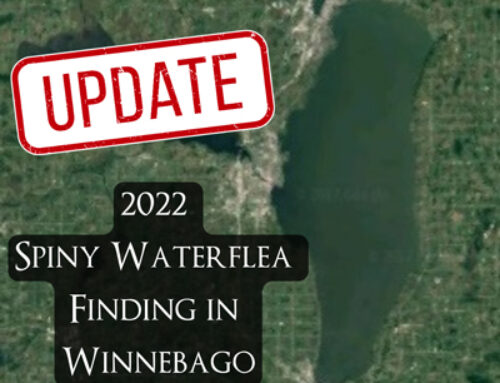When thinking of invasive species, people often tend to picture zebra mussels, submerged aquatic vegetation like Eurasian water milfoil, or perhaps Asian carp. However, there are many other plant and animal aquatic invasive species that are trying to establish populations in our waterways. Water hyacinth is a free-floating perennial plant that is native to South America. This plant has thick, green, waxy leaves that are attached to an inflated petiole that helps keep the plant afloat and upright. The roots hang below the plant in the water. In addition, the lavender flowers have a yellow spot in a larger blue-purple blotch on a petal.
Water hyacinth reproduces very quickly (doubling in as little as 6 days) and forms large, dense mats that can interfere with boating, swimming, and other  waterway uses. These mats can quickly reduce the dissolved oxygen in the water which affects underwater animals such as fish. Since the mats can grow very large, very little sunlight can reach the bottom of the lake or stream, leading to a reduction of native plant growth. The seeds that are produced by the plant can also lay dormant for 15-20 years and still successfully germinate.
waterway uses. These mats can quickly reduce the dissolved oxygen in the water which affects underwater animals such as fish. Since the mats can grow very large, very little sunlight can reach the bottom of the lake or stream, leading to a reduction of native plant growth. The seeds that are produced by the plant can also lay dormant for 15-20 years and still successfully germinate.
Due to its unique shape and colorful flowers, this plant was originally brought to the United States for the World’s Industrial and Cotton Centennial Exposition of 1884-1885 in Louisiana—a.k.a. the 1884 World’s Fair in New Orleans. At the Fair, the plant was given away to visitors. One visitor returned home to Florida and put her new water hyacinth in her fish pond. Soon the plant choked her pond and so she removed some of the plants and put them in the nearby St. John’s River. A New Zealand newspaper later reported that, “A field of it completely covers the water, and no steamboat can penetrate it beyond a short distance.” From there, the plant very quickly spread to neighboring states. By 1910, the plant was choking many major waterways and efforts to eradicate the plant—including one attempt by the US War Department to pour oil on the plant—were not working.
Simultaneously, America was facing a meat shortage with growing populations in cities and overgrazed  rangelands. The New Foods Society proposed importing hippos to America as a meat source. You might be asking: Why hippos? The New Foods Society reasoned that cows, sheep, and poultry had been brought to the United States as food sources, and there were examples of other exotic animals such as African camels being brought to the Southwest United States. The hippos would be able to be released into areas were cattle farming would be impossible such as in lakes, swamps, and bayous.
rangelands. The New Foods Society proposed importing hippos to America as a meat source. You might be asking: Why hippos? The New Foods Society reasoned that cows, sheep, and poultry had been brought to the United States as food sources, and there were examples of other exotic animals such as African camels being brought to the Southwest United States. The hippos would be able to be released into areas were cattle farming would be impossible such as in lakes, swamps, and bayous.
The idea of importing hippos caught the attention of Louisiana Congressman Robert Broussard. He also saw an opportunity to deal with the water hyacinth issue in the Southern US. Hippos had been observed eating water hyacinth in Africa, where it had been introduced into Rwanda and Egypt as ornamental plants.
Thus, Broussard introduced the “American Hippo Bill” (H.R 23621) as a way to provide a new source of meat to America while also reducing the water hyacinth population. The bill, if approved, would have provided $250,000 ($6,223,378 today) for the “importation of useful animals” (a.k.a. hippos). Surprise! The bill did not pass the House of Representatives. However it only fell short by one vote.
Water Hyacinth Monitoring in Lake Winneconne
While we will never know if hippos would have reduced the number of water hyacinth choking Southern waterways, the plant has continued to invade the United States, including Wisconsin. The species was a popular ornamental plant in water gardens  and ponds before being listed as a Prohibited species under Wis. Adm. Code ch. NR 40. Under NR40, Prohibited species such as water hyacinth cannot be transported, possessed, transferred, or introduced without a permit issued by DNR. Water hyacinth has previously been found in local waterways in 8 Wisconsin counties, including in Lake Winneconne in Winnebago County. The plant was first reported to the DNR in October 2015 by a citizen volunteer. Due to its ability to quickly dominate a system, there is concern that the plant may be able to establish a population in the lake. With local partners, the DNR coordinated efforts in October and early November 2015 to remove all water hyacinth plants that were found. As a sub-tropical plant, there was hope that the cold Wisconsin winter would eliminate any plants that were potentially missed by the removal efforts. However, in September 2016, more water hyacinth plants were located in the same area of Lake Winneconne in residential channels and the Wolf River channel. Additional monitoring and removal occurred in September and October 2016, and no plants were located in a follow up monitoring event in June 2017.
and ponds before being listed as a Prohibited species under Wis. Adm. Code ch. NR 40. Under NR40, Prohibited species such as water hyacinth cannot be transported, possessed, transferred, or introduced without a permit issued by DNR. Water hyacinth has previously been found in local waterways in 8 Wisconsin counties, including in Lake Winneconne in Winnebago County. The plant was first reported to the DNR in October 2015 by a citizen volunteer. Due to its ability to quickly dominate a system, there is concern that the plant may be able to establish a population in the lake. With local partners, the DNR coordinated efforts in October and early November 2015 to remove all water hyacinth plants that were found. As a sub-tropical plant, there was hope that the cold Wisconsin winter would eliminate any plants that were potentially missed by the removal efforts. However, in September 2016, more water hyacinth plants were located in the same area of Lake Winneconne in residential channels and the Wolf River channel. Additional monitoring and removal occurred in September and October 2016, and no plants were located in a follow up monitoring event in June 2017.
Partnering with staff from the Wisconsin DNR, Golden Sands Resource Conservation and Development, River Alliance of Wisconsin, and citizen volunteers, the staff from Fox-Wolf Watershed Alliance went to Lake Winneconne and the Wolf River channel on September 14, 2017 to help search for water hyacinth. Armed with 6 kayaks and 3 motor boats, the team scoured all the areas where water hyacinth had been found in 2015 and 2016. Three water hyacinth plants were found in a residential channel near Lake Winneconne park (indicated by the red triangle on the map below) and were removed from the system! No other water hyacinth was found in the system. Additional reconnaissance monitoring is scheduled to occur in October 2017.
 While we do not have American hippos reducing the number of water hyacinth, our team of FWWA staff, partners, and awesome citizen volunteers are actively reducing the risk of water hyacinth in Lake Winneconne!
While we do not have American hippos reducing the number of water hyacinth, our team of FWWA staff, partners, and awesome citizen volunteers are actively reducing the risk of water hyacinth in Lake Winneconne!
If you are interested in becoming a citizen volunteer to help with similar projects, contact Chris Acy, Winnebago Waterways AIS Coordinator, at chris@fwwa.org or (920)460-3674. For more information about similar aquatic invasive species monitoring projects, visit http://WinnebagoWaterways.org.
Winnebago Waterways is a Fox-Wolf Watershed Alliance program. The Fox-Wolf Watershed Alliance is an independent nonprofit organization that identifies and advocates effective policies and actions that protect, restore, and sustain water resources in the Fox-Wolf River Basin.
To learn more about water hyacinth and its impact to Wisconsin’s waters and economy, visit http://dnr.wi.gov/topic/Invasives/. If you think you have found a population of water hyacinth (or other unreported aquatic invasive species), contact Chris Acy at the contact information listed above.
This article was written by Chris Acy, the AIS Coordinator for the Winnebago Waterways Program.








